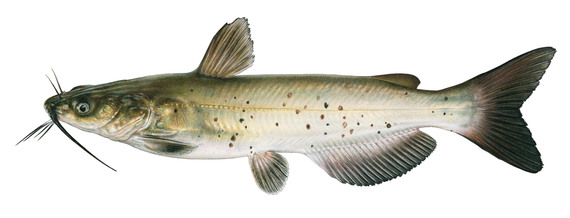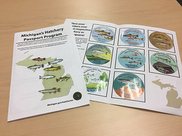|
|
|
July 2017
Welcome to the 11th edition of Fish Bites! This e-newsletter is made specifically for students, parents and teachers. Expect to receive Fish Bites about four times each year and have your friends sign-up too!
Can you name this Michigan fish species? Scroll to the bottom to find out!
Illustration by Joseph R. Tomelleri ©

|
|
In the Current
Four Fun Fishy Facts:

- Lake Michigan’s name comes from the Ojibwa word “mishigami”, which means large lake.
- Most fish have taste buds all over their body.
- Michigan’s inland lakes cover more than 890,000 acres.
- A fish does not add new scales as it grows, but the scales it has increase in size.
|
Don't forget to Take an Adult Fishing!
 Are you constantly asking your mom, dad or another adult in your life when you’re going to go fishing again? Why not plan your next outing for Saturday, August 5?
That day will be Michigan’s first-ever Take an Adult Fishing Day. On that day we’ll ask anybody who takes an adult fishing to share their picture with us using the hashtag #TakeAnAdultFishing. We’ll randomly select a few winners to receive a fishing gear prize!
Just get your gear together, find the perfect place to fish, and then ask the person you’d like to go with. You could find a spot nearby by searching through the Family Friendly Fishing Waters website or plan a visit to one of several state parks or visitor centers that offer instruction on how to fish through the Hook, Line and Sinker program. The options are almost endless!
Still not convinced? Check out our official Take an Adult Fishing video!!
|
 Hatchery Passport Program
Have you ever visited one of Michigan's six state fish hatcheries or one of the state's various egg-take facilities? The DNR's new Hatchery Passport Program just might be a great way to start planning a visit!
Participants of the Hatchery Passport Program simply do the following:
1. Pick up a copy hard copy or download an electronic version of the Hatchery Passport Program document.
2. Plan a visit to any of the following hatcheries: Harrietta State Fish Hatchery in Harrietta, Marquette State Fish Hatchery in Marquette, Oden State Fish Hatchery in Alanson, Platte River State Fish Hatchery in Beulah, Thompson State Fish Hatchery in Manistique, or Wolf Lake State Fish Hatchery in Mattawan. The following weirs are BONUS locations: Boardman River Weir in Traverse City or Little Manistee River Weir in Stronach.
3. Collect an official sticker at each of the eight participating locations and add it to your Hatchery Passport Program document.
4. Once you fill your Hatchery Passport Program document (no time allotment required), simply send us a copy or photo and we'll mail you a small package of fisheries-related materials!
|
Fun with Fish Activities
Name that Fish: Channel Catfish
 Channel catfish live in a diverse array of habitats, including four of the five Great Lakes (Lake Superior excluded), inland lakes and medium to large rivers. They are most common in the southern half of the Lower Peninsula. In rivers, young channel catfish generally are found in shallow riffles. Adult catfish typically inhabit deep pools with log jams or rocks for cover during the day and move into shallow water at night.
These fish feed both day and night. They take a large part of their food from the bottom, but they also feed at the surface and are better adapted to sight feeding than other catfish species. Young fish feed primarily on aquatic insects and other aquatic invertebrates. Adult catfish consume a wide variety of plant and animal materials, including fish, frogs, crayfish, insects, mollusks, algae and pondweeds.
The best fishing periods for channel catfish are from dusk until midnight or when water levels are rising (i.e., after rains have washed food into the lake or stream).
In the late spring or early summer, male channel catfish build nests in dark, secluded areas such as underwater holes or undercut banks, log jams or rocks. The female leaves the nest soon after depositing the eggs, while the male stays behind to protect and fan the eggs. The eggs hatch in five to 10 days. Fry normally remain in the nest, protected by the male catfish, for about seven days after hatching.
Channel catfish are capable of living more than 15 years, and individuals up to 24 years of age have been reported. In productive waters, channel catfish often grow to more than 30 inches and weigh more than 10 pounds. The current state record channel catfish weighed 40 pounds.
Check out even more information on their Michigan Fish and How to Catch Them page!
|
|
|
|
|
|